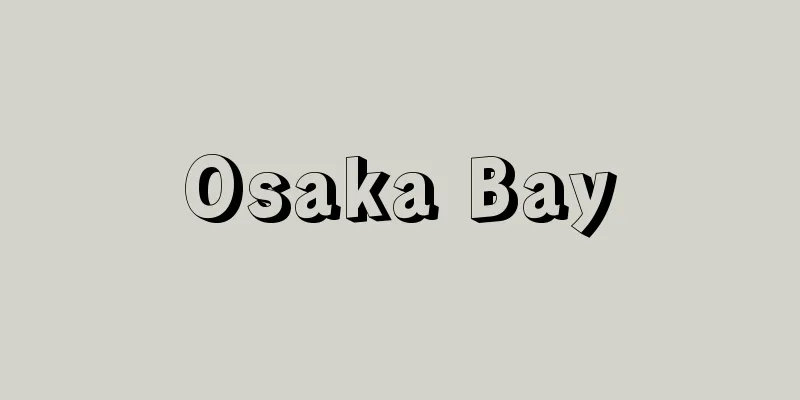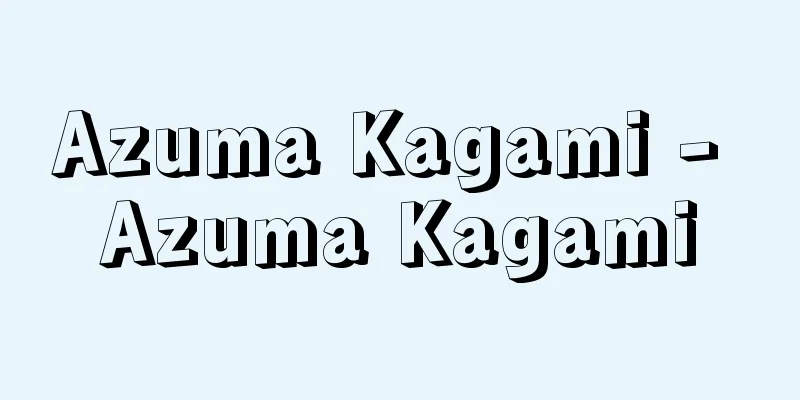Osaka Bay

|
A sunken bay at the eastern end of the Seto Inland Sea. It is an inland bay surrounded by the Osaka Plain to the east, Awaji Island to the west, the Rokko Mountains to the north, and the Izumi Mountains to the south. It connects to the Harima Nada Sea through the Akashi Strait at its northwestern end, and to the Pacific Ocean through the Kii Channel at Tomogashima Island in the south. The bay is elliptical, with a long axis running about 60 km from the northeast to the southwest and a short axis running about 30 km from the northwest to the southeast. Its area is about 1,500 square kilometers. The seabed is deep on the west side and shallow on the east side, with an average depth of 27 meters. Its maximum depth is 197 meters in the Kitan Strait area. The fastest tidal current is 12 kilometers per hour in the Akashi Strait. The movement of seawater in the bay, combined with the influence of river water, forms a constant clockwise current over the long term, which is related to the distribution of the water quality and bottom sediment in the bay. The average tidal range is 60 centimeters, and the highest tide level ever recorded was 4.6 meters on September 21, 1934 (Showa 9), during the Muroto Typhoon (First Muroto Typhoon), and has since become the standard for designing seawalls along the bay. Osaka Bay was formerly known as Chinu no Umi, and had many scenic spots with white sand and green pines. Suma, Maiko, and Hamadera have been written about in poetry, but now many of these have been replaced by artificial concrete seawalls. It is said that Osaka was given the name "Naniwa" because it was a "fish garden" (naniwa) blessed with fish and shellfish such as black porgy. Although the amount of fish caught and the number of fishing households are declining, there are about 230 species of fish and shellfish, such as flounder, shrimp, and crabs in the sandy and muddy coastal areas, black porgy, rockfish, and octopus in the rocky reefs, sea bass and mullet in the estuaries, and sardines near the surface. These are caught using a variety of fishing methods, and the amount of fish caught per area is almost twice that of the Seto Inland Sea. Osaka Bay has long been blessed with maritime transport linking the Seto Inland Sea and Kinai, and ports such as Naniwa, Hyogo, and Sakai have flourished. Since the Meiji period, modern industry has developed along the coast, centered on the two major trading ports of Osaka and Kobe, forming the Hanshin Industrial Zone, with cities such as Nishinomiya and Amagasaki, Sakai, and Kishiwada. The coast has been reclaimed to create Kobe Port Island, Rokko Island, Maishima and Yumeshima in Osaka North Port, Sakishima in Nanko, and the Sakai-Senboku coastal industrial zone. Furthermore, in 1994, Kansai International Airport, Japan's first airport capable of 24-hour operation, opened off the coast of Senshu. Many of these reclaimed areas are concentrated in shallow waters less than 10 meters deep, and careful attention must be paid to the impact they have on the ecosystem. [Juichi Inoki and Tsukasa Yasui] [References] | | | | | | | |Photographed from the south. Osaka Prefecture, Izumisano City, Tajiri Town, Sennan District, Sennan City ©Shogakukan "> Kansai International Airport Source: Shogakukan Encyclopedia Nipponica About Encyclopedia Nipponica Information | Legend |
|
瀬戸内海東端の陥没湾。東は大阪平野、西は淡路(あわじ)島、北は六甲(ろっこう)山地、南は和泉(いずみ)山脈に囲まれた内湾で、北西端の明石(あかし)海峡を通じて播磨灘(はりまなだ)に、南の友ヶ島で紀伊水道を経て太平洋につながっている。湾形は楕円(だえん)状で、長軸は北東―南西約60キロメートル、短軸は北西―南東約30キロメートル。面積は約1500平方キロメートル。海底は西側は深く、東側に浅く、平均水深27メートル。最大水深は紀淡海峡の部分で197メートルに及ぶ。潮流でもっとも速いのは明石海峡の毎時12キロメートル。湾内の海水の移動は河川水の影響とあわせ、長い時間でみると恒流とよばれる時計回りとなり、湾内の水質や底質の分布にも関係する。平均潮差は60センチメートル、過去の最高潮位は1934年(昭和9)9月21日、室戸(むろと)台風(第一室戸台風)時に記録したプラス4.6メートルで、以来湾岸の防潮堤設計の基準となっている。 大阪湾は、古くは茅渟海(ちぬのうみ)ともよばれ、白砂青松の景勝地が多く、須磨(すま)、舞子(まいこ)、浜寺などは詩歌に詠まれてきたが、いまでは多くはコンクリートの人工護岸に変わっている。 大阪が「なにわ」とよばれたのは、チヌ(クロダイ)をはじめとする魚貝類に恵まれた、「魚の庭(なのにわ)」からだともいわれる。漁獲高や漁家数は減少しているが、沿岸の砂泥域にカレイ、エビ、カニ、岩礁域にはクロダイ、カサゴ、マダコ、河口域にはスズキ、ボラ、表層付近にはイワシなど約230種の魚貝類がおり、種々の漁法で漁獲され、面積当りの漁獲量は瀬戸内海のほぼ2倍になる。 大阪湾では、古くから瀬戸内海と畿内を結ぶ舟運に恵まれ、難波(なにわ)、兵庫、堺(さかい)などの港が栄えてきた。明治以降も大阪、神戸の二大貿易港を中心に沿岸に近代工業が発達し、西宮、尼崎(あまがさき)から堺、岸和田などの都市の並ぶ阪神工業地帯を形成している。海岸を埋め立てて、神戸ポートアイランド、六甲アイランド、大阪北港の舞洲(まいしま)・夢洲(ゆめしま)、南港の咲洲(さきしま)、堺・泉北臨海工業地帯などを造成した。さらに泉州沖には1994年(平成6)、日本最初の24時間運用可能な関西国際空港が開港した。このような埋立地の多くは水深10メートル以下の浅海域に集中しており、生態系へ及ぼす影響には細心の注意が必要である。 [位野木壽一・安井 司] [参照項目] | | | | | | | |南方上空より撮影。大阪府泉佐野市・泉南郡田尻町・泉南市©Shogakukan"> 関西国際空港 出典 小学館 日本大百科全書(ニッポニカ)日本大百科全書(ニッポニカ)について 情報 | 凡例 |
>>: Osakaya Ihei - Osakaya Ihei
Recommend
Revenge at Igagoe
One of the famous vendettas in the Edo period. Wat...
Mayer-Gross, W. (English spelling) MayerGrossW
…A group of researchers who worked mainly in the ...
Worms Cathedral - Wormser Dom
This is a cathedral in the city of Worms on the R...
Doritis
...In Japan, it often blooms from winter to early...
Activity Peep - Activity Peep
...They were not made much in the latter half of ...
Otozuregawa - Otozuregawa
…It is also called Nagato Yumoto Onsen. It is a h...
Stilts - Takeuma
A child's toy consists of two bamboo poles wi...
Aligarh (English spelling)
A commercial city in the western part of Uttar Pra...
Sayagata - Sayagata
A type of pattern. It is a type of manji pattern,...
Stone stick
A rod-shaped stone product made from the middle t...
Eastern Japan
A geographical concept of Japan before the modern ...
Aries, P. - Aries
...Recently, there have been frequent attempts to...
Kosanji Temple
This is a Jodo Shinshu Honganji temple in Onomich...
Gyokujo - Jeweled staff
One of the jasper products from the 4th century ex...
Rong-lu; Jung-lu
[Born] Daoguang 16 (1836) [Died] 1903 A Chinese of...



![Spaniel [species] (English spelling) spaniel](/upload/images/67cbf85d3c585.webp)





